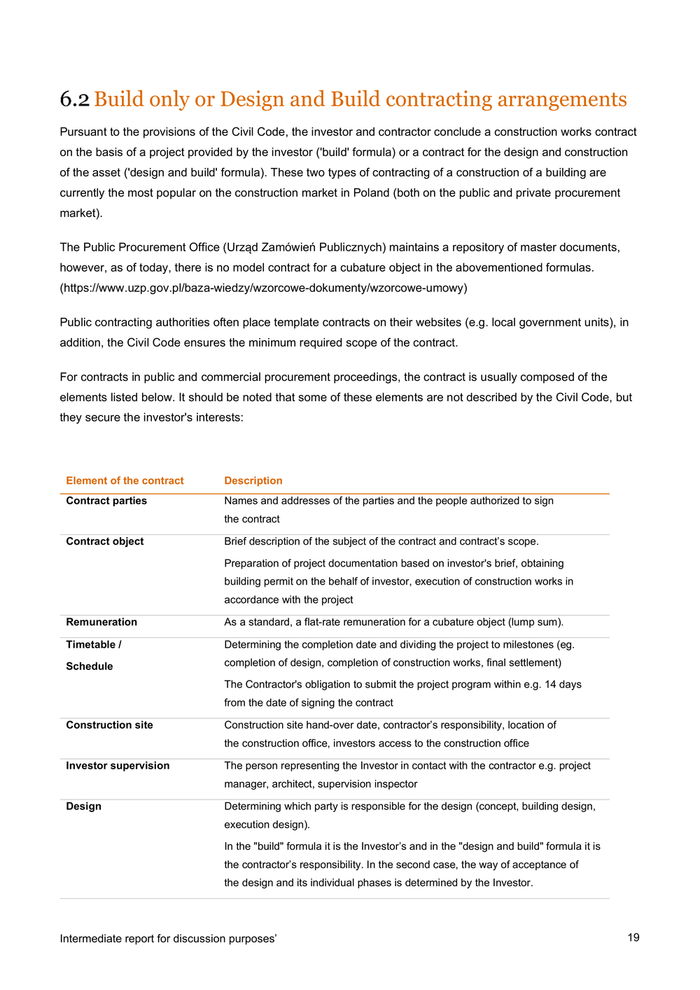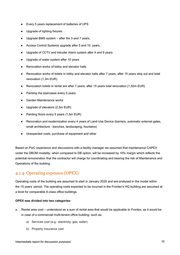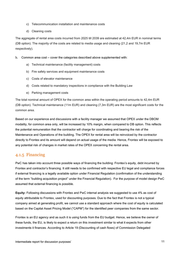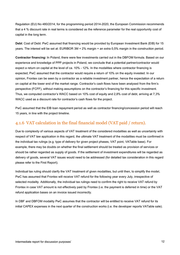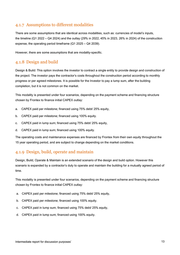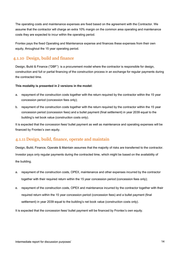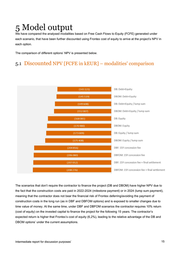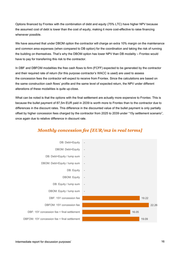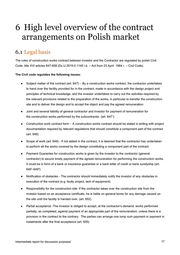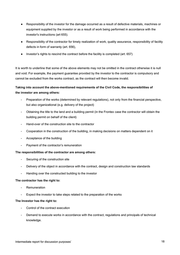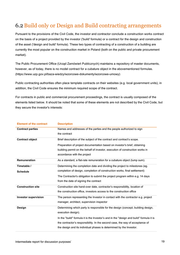Microsoft Word - Intermediate report for discussion purposes
Dieses Dokument ist Teil der Anfrage „Ausschreibungen zum Bau des neuen Hauptquartiers in Warschau“
● Every 5 years replacement of batteries of UPS ● Upgrade of lighting fixtures ● Upgrade BMS system – after the 3 and 7 years, ● Access Control Systems upgrade after 5 and 10 years, ● Upgrade of CCTV and Intruder Alarm system after 4 and 9 years ● Upgrade of water system after 10 years ● Renovation works of lobby and elevator halls ● Renovation works of toilets in lobby and elevator halls after 7 years, after 15 years strip out and total renovation (1,3m EUR) ● Renovation toilets in rental are after 7 years, after 15 years total renovation (1,52m EUR) ● Painting the staircases every 5 years ● Garden Maintenance works ● Upgrade of elevators (2,5m EUR) ● Painting floors every 5 years (1,5m EUR) ● Renovation and modernization every 4 years of Land-Use Device (barriers, automatic external gates, small architecture - benches, landscaping, fountains) ● Unexpected costs, purchase of equipment and other Based on PwC experience and discussions with a facility manager we assumed that maintenance CAPEX under the DBOM modality, when compared to DB option, will be increased by 10% margin which reflects the potential remuneration that the contractor will charge for coordinating and bearing the risk of Maintenance and Operations of the building. 4.1.4 Operating expenses (OPEX) Operating costs of the building are assumed to start in January 2025 and are analysed in the model within the 15 years’ period. The operating costs expected to be incurred in the Frontex’s HQ building are assumed at a level for comparable A-class office buildings. OPEX was divided into two categories: a. Rental area cost – understood as a sum of rental area that would be applicable to Frontex, as it would be in case of a commercial multi-tenant office building- such as: a) Services cost (e.g.: electricity, gas, water) b) Property Insurance cost Intermediate report for discussion purposes’ 10
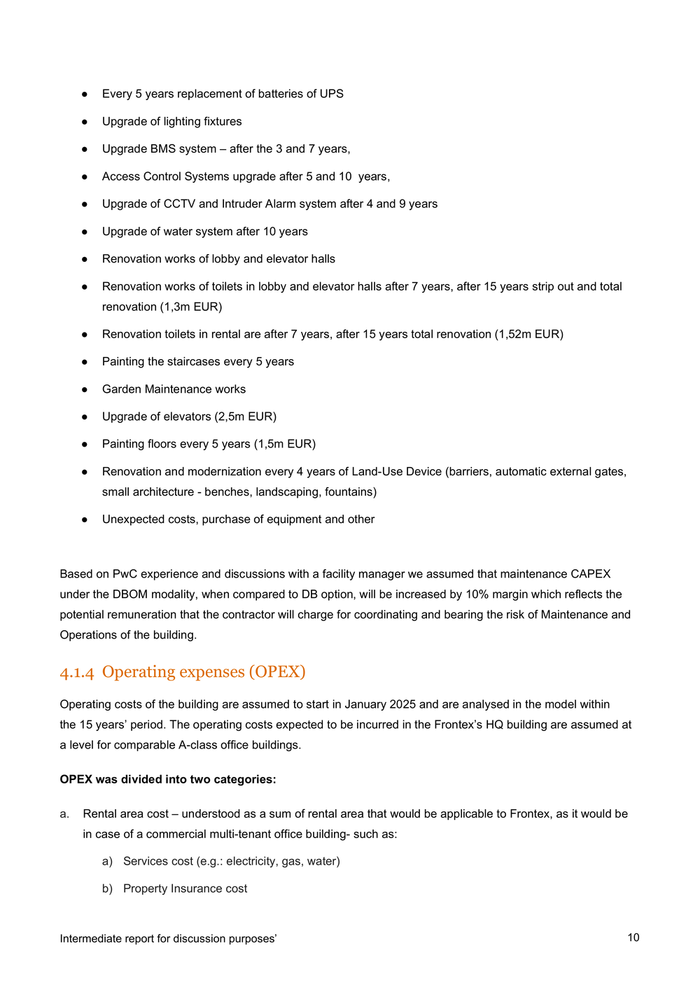
c) Telecommunication installation and maintenance costs d) Cleaning costs The aggregate of rental area costs incurred from 2025 till 2039 are estimated at 42,4m EUR in nominal terms (DB option). The majority of the costs are related to media usage and cleaning (21,2 and 19,7m EUR respectively). b. Common area cost – cover the categories described above supplemented with: a) Technical maintenance (facility management) costs b) Fire safety services and equipment maintenance costs c) Costs of elevator maintenance d) Costs related to mandatory inspections in compliance with the Building Law e) Parking management costs The total nominal amount of OPEX for the common area within the operating period amounts to 42,4m EUR (DB option). Technical maintenance (11m EUR) and cleaning (7,3m EUR) are the most significant costs for the common area. Based on our experience and discussions with a facility manager we assumed that OPEX under the DBOM modality, for common area only, will be increased by 10% margin, when compared to DB option. This reflects the potential remuneration that the contractor will charge for coordinating and bearing the risk of the Maintenance and Operations of the building. The OPEX for rental area will be reinvoiced by the contractor directly to Frontex and its amount will depend on actual usage of the media. Hence, Frontex will be exposed to any potential risk of changes in market rates of the OPEX concerning the rental area. 4.1.5 Financing PwC has taken into account three possible ways of financing the building: Frontex’s equity, debt incurred by Frontex and contractor’s financing. It still needs to be confirmed with respective EU legal and compliance forces if external financing is a legally available option under Financial Regulation (confirmation of the understanding of the term “building acquisition project” under the Financial Regulation). For the purpose of model design PwC assumed that external financing is possible. Equity: Following discussions with Frontex and PwC internal analysis we suggested to use 4% as cost of equity attributable to Frontex, used for discounting purposes. Due to the fact that Frontex is not a typical company aimed at generating profit, we cannot use a standard approach where the cost of equity is calculated based on the Capital Asset Pricing Model (“CAPM”) for the identified peer companies from the same sector. Frontex is an EU agency and as such it is using funds from the EU budget. Hence, we believe the owner of these funds, the EU, is likely to expect a return on this investment similar to what it expects from other investments it finances. According to Article 19 (Discounting of cash flows) of Commission Delegated Intermediate report for discussion purposes’ 11
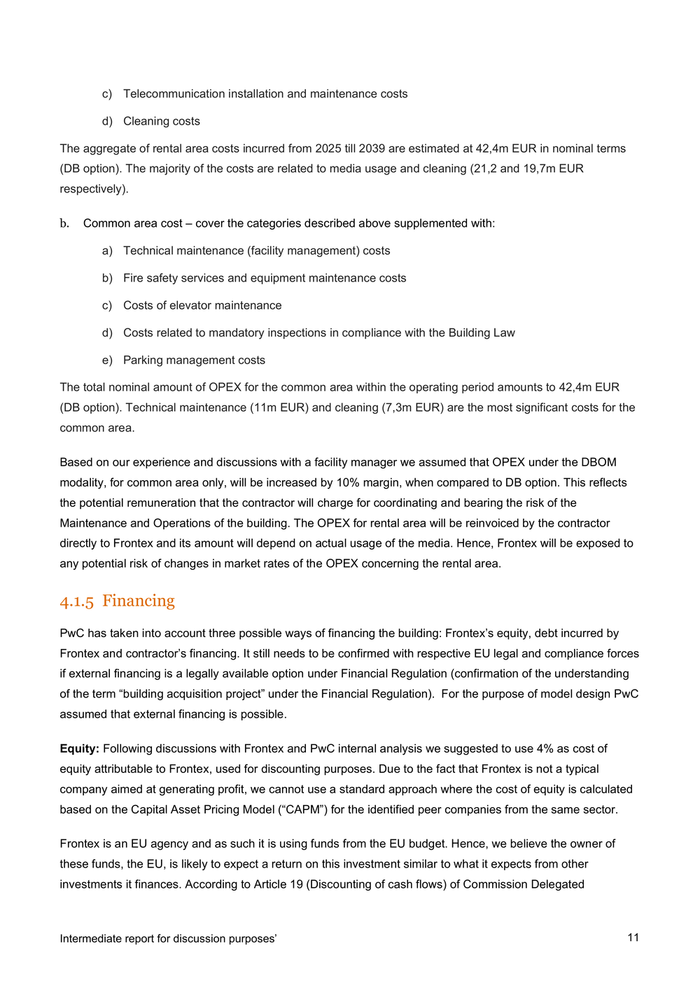
Regulation (EU) No 480/2014, for the programming period 2014-2020, the European Commission recommends that a 4 % discount rate in real terms is considered as the reference parameter for the real opportunity cost of capital in the long term. Debt: Cost of Debt. PwC assumed that financing would be provided by European Investment Bank (EIB) for 15 years. The interest will be set at: EURIBOR 3M + 2% margin + an extra 0,5% margin in the construction period. Contractor financing: In Poland, there were few investments carried out in the DBFOM formula. Based on our experience and knowledge of PPP projects in Poland, we conclude that a potential partner/contractor would expect a return on capital at the level of ca. 10% - 12%. In the modalities where contractor financing is expected, PwC assumed that the contractor would require a return of 10% on the equity invested. In our opinion, Frontex can be seen by a contractor as a reliable investment partner, hence the expectation of a return on capital at the lower end of the market range. Contractor’s cash flows have been analysed from the firm’s perspective (FCFF), without making assumptions on the contractor’s financing for this specific investment. Thus, we computed contractor’s WACC based on 10% cost of equity and 2,8% cost of debt, arriving at 7,3% WACC used as a discount rate for contractor’s cash flows for the project. PwC assumed that the EIB loan repayment period as well as contractor financing/concession period will reach 15 years, in line with the project timeline. 4.1.6 VAT calculation in the final financial model (VAT paid / return). Due to complexity of various aspects of VAT treatment of the considered modalities as well as uncertainty with respect of VAT law application in this regard, the ultimate VAT treatment of the modalities must be confirmed in the individual tax rulings (e.g. type of delivery for given project phases, VAT point, VATable base). For example, there may be doubts on whether the final settlement should be treated as provision of services or should be rather regarded as supply of goods. If the settlement of investment expenditures will be regarded as delivery of goods, several VAT issues would need to be addressed (for detailed tax consideration in this regard please refer to the First Report). Individual tax ruling should clarify the VAT treatment of given modalities, but until then, to simplify the model, PwC has assumed that Frontex will receive VAT refund for the following year every July, irrespective of selected modality. Additionally, the individual tax rulings need to confirm the right to receive VAT refund by Frontex in case VAT amount is not effectively paid by Frontex (i.e. the payment is deferred in time) or the VAT refund application bases on an invoice issued incorrectly. In DBF and DBFOM modality PwC assumes that the contractor will be entitled to receive VAT refund for its initial CAPEX expenses in the next quarter of the construction works (i.e. the developer reports VATable sale). Intermediate report for discussion purposes’ 12
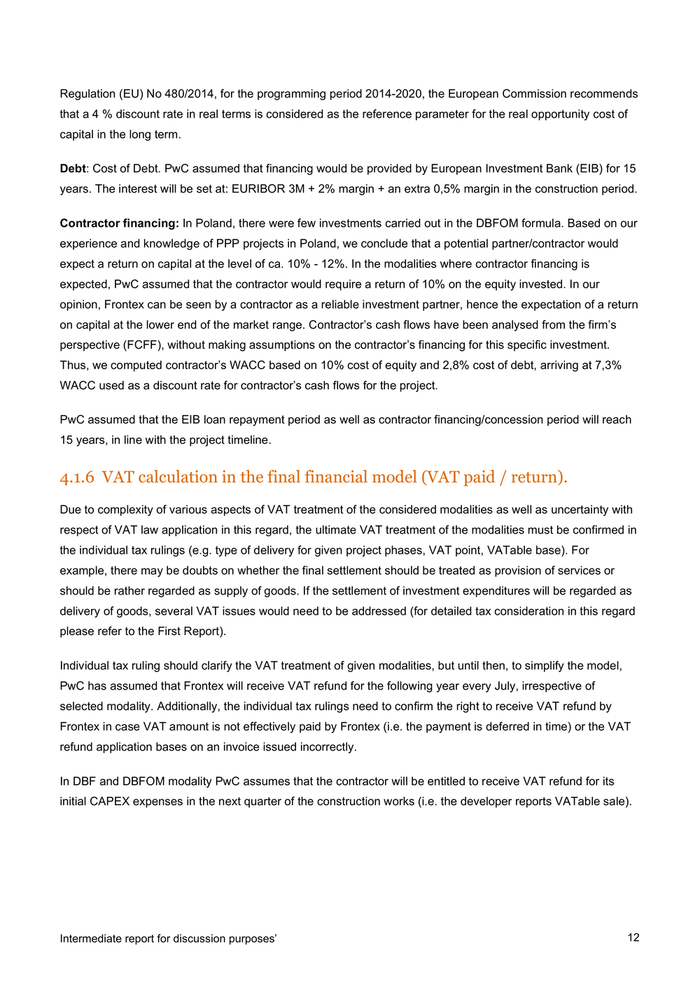
4.1.7 Assumptions to different modalities There are some assumptions that are identical across modalities, such as: currencies of model’s inputs, the timeline (Q1 2022 – Q4 2024) and the outlay (29% in 2022, 45% in 2023, 26% in 2024) of the construction expense, the operating period timeframe (Q1 2025 – Q4 2039). However, there are some assumptions that are modality-specific. 4.1.8 Design and build Design & Build: This option involves the investor to contract a single entity to provide design and construction of the project. The investor pays the contractor’s costs throughout the construction period according to monthly progress or per agreed milestones. It is possible for the Investor to pay a lump sum, after the building completion, but it is not common on the market. This modality is presented under four scenarios, depending on the payment scheme and financing structure chosen by Frontex to finance initial CAPEX outlay: a. CAPEX paid per milestone; financed using 75% debt/ 25% equity, b. CAPEX paid per milestone; financed using 100% equity. c. CAPEX paid in lump sum; financed using 75% debt/ 25% equity, d. CAPEX paid in lump sum; financed using 100% equity. The operating costs and maintenance expenses are financed by Frontex from their own equity throughout the 15 year operating period, and are subject to change depending on the market conditions. 4.1.9 Design, build, operate and maintain Design, Build, Operate & Maintain is an extended scenario of the design and build option. However this scenario is expanded by a contractor’s duty to operate and maintain the building for a mutually agreed period of time. This modality is presented under four scenarios, depending on the payment scheme and financing structure chosen by Frontex to finance initial CAPEX outlay: a. CAPEX paid per milestone; financed using 75% debt/ 25% equity, b. CAPEX paid per milestone; financed using 100% equity. c. CAPEX paid in lump sum; financed using 75% debt/ 25% equity, d. CAPEX paid in lump sum; financed using 100% equity. Intermediate report for discussion purposes’ 13
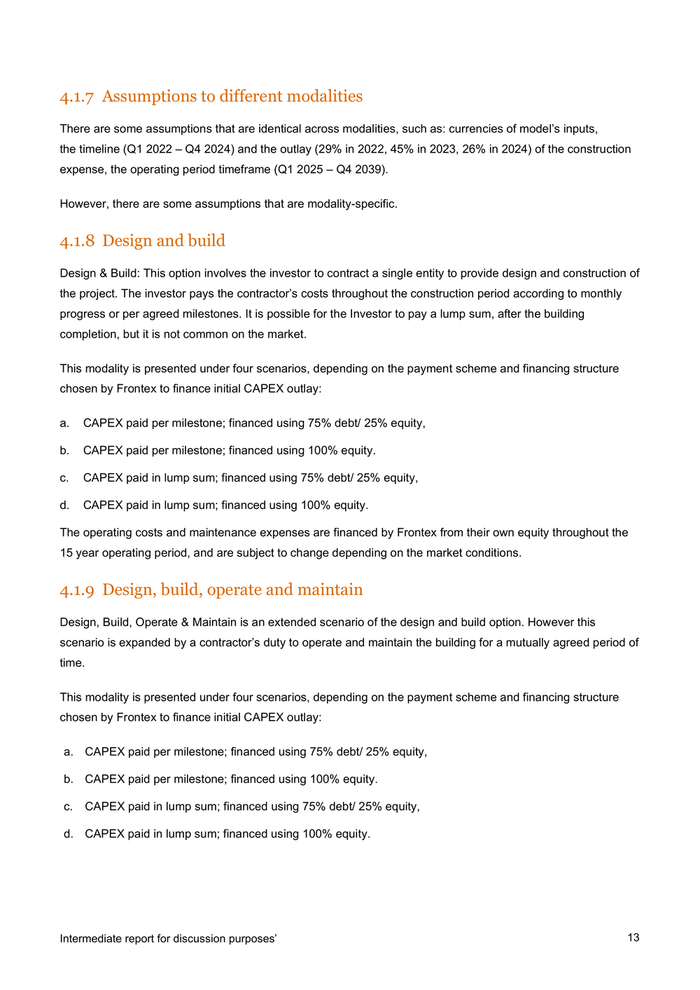
The operating costs and maintenance expenses are fixed based on the agreement with the Contractor. We assume that the contractor will charge an extra 10% margin on the common area operating and maintenance costs they are expected to incur within the operating period. Frontex pays the fixed Operating and Maintenance expense and finances these expenses from their own equity, throughout the 15 year operating period. 4.1.10 Design, build and finance Design, Build & Finance (“DBF”) is a procurement model where the contractor is responsible for design, construction and full or partial financing of the construction process in an exchange for regular payments during the contracted time. This modality is presented in 2 versions in the model: a. repayment of the construction costs together with the return required by the contractor within the 15 year concession period (concession fees only); b. repayment of the construction costs together with the return required by the contractor within the 15 year concession period (concession fees) and a bullet payment (final settlement) in year 2039 equal to the building’s net book value (construction costs only). It is expected that the concession fees/ bullet payment as well as maintenance and operating expenses will be financed by Frontex’s own equity. 4.1.11 Design, build, finance, operate and maintain Design, Build, Finance, Operate & Maintain assumes that the majority of risks are transferred to the contractor. Investor pays only regular payments during the contracted time, which might be based on the availability of the building. a. repayment of the construction costs, OPEX, maintenance and other expenses incurred by the contractor together with their required return within the 15 year concession period (concession fees only); e. repayment of the construction costs, OPEX and maintenance incurred by the contractor together with their required return within the 15 year concession period (concession fees) and a bullet payment (final settlement) in year 2039 equal to the building’s net book value (construction costs only). It is expected that the concession fees/ bullet payment will be financed by Frontex’s own equity. Intermediate report for discussion purposes’ 14
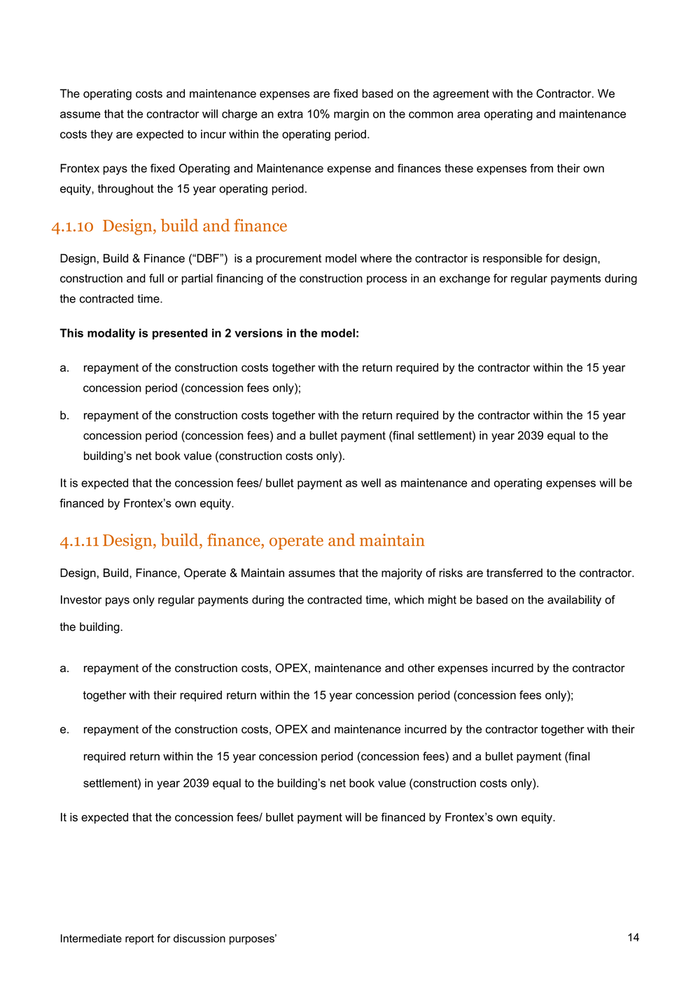
5 Model output We have compared the analysed modalities based on Free Cash Flows to Equity (FCFE) generated under each scenario, that have been further discounted using Frontex cost of equity to arrive at the project’s NPV in each option. The comparison of different options’ NPV is presented below. Discounted NPV [FCFE in kEUR] – modalities' comparison The scenarios that don’t require the contractor to finance the project (DB and DBOM) have higher NPV due to the fact that the construction costs are paid in 2022-2024 (milestone payment) or in 2024 (lump sum payment), meaning that the contractor does not bear the financial risk of Frontex deferring/avoiding the payment of construction costs in the long run (as in DBF and DBFOM options) and is exposed to smaller changes due to time value of money. At the same time, under DBF and DBFOM scenarios the contractor requires 10% return (cost of equity) on the invested capital to finance the project for the following 15 years. The contractor’s expected return is higher that Frontex’s cost of equity (6,2%), leading to the relative advantage of the DB and DBOM options’ under the current assumptions. Intermediate report for discussion purposes’ 15

Options financed by Frontex with the combination of debt and equity (75% LTC) have higher NPV because the assumed cost of debt is lower than the cost of equity, making it more cost-effective to raise financing whenever possible. We have assumed that under DBOM option the contractor will charge an extra 10% margin on the maintenance and common area expenses (when compared to DB option) for the coordination and taking the risk of running the building on themselves. That’s why the DBOM option has lower NPV than DB modality – Frontex would have to pay for transferring this risk to the contractor. In DBF and DBFOM modalities the free cash flows to firm (FCFF) expected to be generated by the contractor and their required rate of return (for this purpose contractor’s WACC is used) are used to assess the concession fees the contractor will expect to receive from Frontex. Since the calculations are based on the same construction cash flows’ profile and the same level of expected return, the NPV under different alterations of these modalities is quite up-close. What can be noted is that the options with the final settlement are actually more expensive to Frontex. This is because the bullet payment of 87,5m EUR paid in 2039 is worth more to Frontex than to the contractor due to differences in the discount rates. This difference in the discounted value of the bullet payment is only partially offset by higher concession fees charged by the contractor from 2025 to 2039 under “15y settlement scenario”, once again due to relative difference in discount rate. Monthly concession fee [EUR/m2 in real terms] DB: Debt+Equity - DBOM: Debt+Equity - DB: Debt+Equity / lump sum - DBOM: Debt+Equity / lump sum - DB: Equity - DBOM: Equity - DB: Equity / lump sum - DBOM: Equity / lump sum - DBF: 15Y concession fee 19.22 DBFOM: 15Y concession fee 22.26 DBF: 15Y concession fee + final settlement 16.05 DBFOM: 15Y concession fee + final settlement 19.09 Intermediate report for discussion purposes’ 16
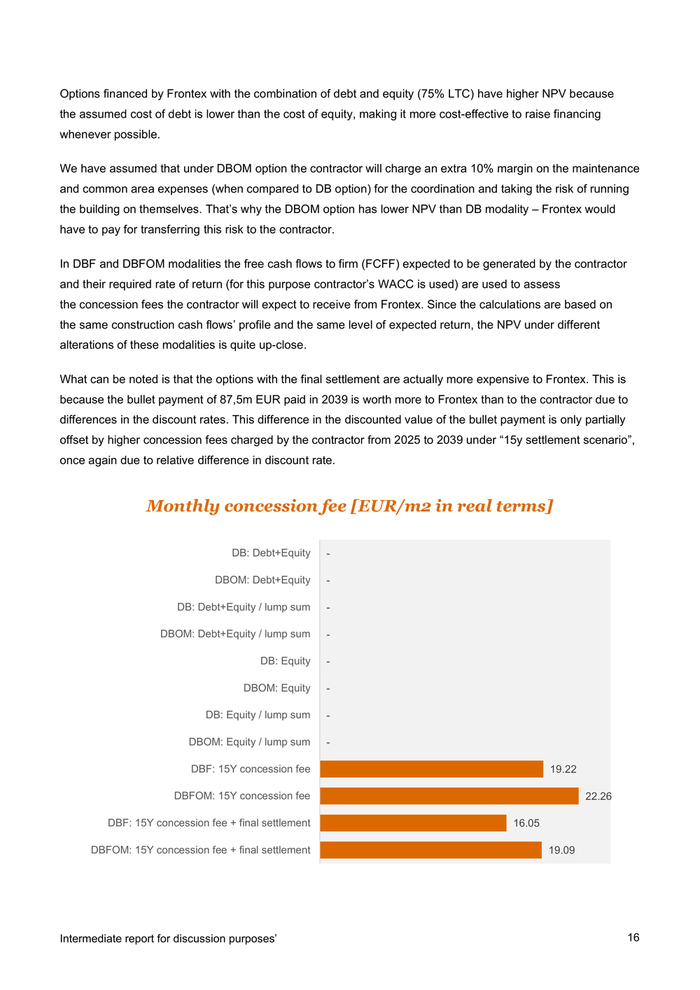
6 High level overview of the contract arrangements on Polish market Legal basis The rules of construction works contract between investor and the Contractor are regulated by polish Civil Code, title XVI articles 647-658 (Dz.U.2019.0.1145 i.e. – Act from 23 April 1964 r. – Civil Code). The Civil code regulates the following issues: ● Subject matter of the contract (art. 647) - By a construction works contract, the contractor undertakes to hand over the facility provided for in the contract, made in accordance with the design project and principles of technical knowledge, and the investor undertakes to carry out the activities required by the relevant provisions related to the preparation of the works, in particular to transfer the construction site and to deliver the design and to accept the object and pay the agreed remuneration ● Joint and several liability of general contractor and investor for payment of remuneration for the construction works performed by the subcontractor. (art. 6471) ● Construction work contract form - A construction works contract should be stated in writing with project documentation required by relevant regulations that should constitute a component part of the contract (art. 648) ● Scope of work (art. 649) - If not stated in the contract, it is deemed that the contractor has undertaken to perform all the works covered by the design constituting a component part of the contract. ● Payment Guarantee for construction works is given by the investor to the contractor (general contractor) to secure timely payment of the agreed remuneration for performing the construction works. It could be in form of a bank or insurance guarantee or a bank letter of credit or bank suretyship (art. 6491-6495) ● Notification of obstacles - The contractor should immediately notify the investor of any obstacles in execution of the contract (e.g. faulty project, lack of equipment) ● Responsibility for the construction site- If the contractor takes over the construction site from the investor based on an acceptance certificate, he is liable on general terms for any damage caused on the site until the facility is handed over. (art. 652) ● Partial acceptance -The investor is obliged to accept, at the contractor's demand, works performed partially, as completed, against payment of an appropriate part of the remuneration, unless there is a provision in the contract to the contrary. The parties can arrange one lump sum payment or payment in instalments after the final acceptance (art. 655) Intermediate report for discussion purposes’ 17
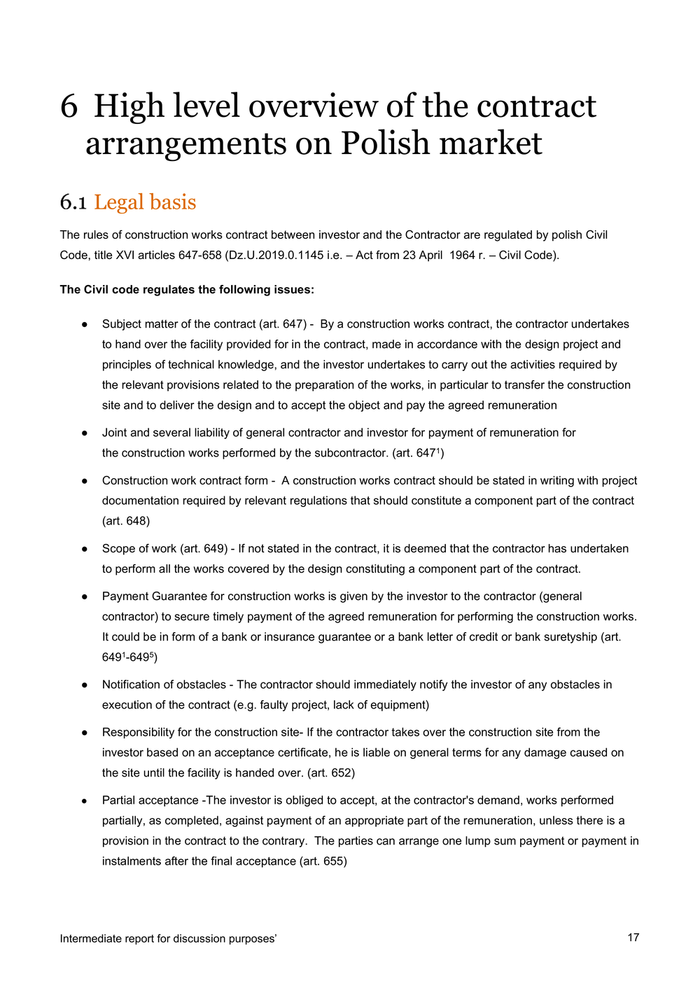
● Responsibility of the investor for the damage occurred as a result of defective materials, machines or equipment supplied by the investor or as a result of work being performed in accordance with the investor's instructions (art 655). ● Responsibility of the contractor for timely realization of work, quality assurance, responsibility of facility defects in form of warranty (art. 656), ● Investor’s rights to rescind the contract before the facility is completed (art. 657) It is worth to underline that some of the above elements may not be omitted in the contract otherwise it is null and void. For example, the payment guarantee provided by the investor to the contractor is compulsory and cannot be excluded from the works contract, as the contract will then become invalid. Taking into account the above-mentioned requirements of the Civil Code, the responsibilities of the investor are among others: - Preparation of the works (determined by relevant regulations), not only from the financial perspective, but also organizational (e.g. delivery of the project) - Obtaining the title to the land and a building permit (in the Frontex case the contractor will obtain the building permit on behalf of the client) - Hand-over of the construction site to the contractor - Cooperation in the construction of the building, in making decisions on matters dependent on it - Acceptance of the building - Payment of the contractor’s remuneration The responsibilities of the contractor are among others: - Securing of the construction site - Delivery of the object in accordance with the contract, design and construction law standards - Handing over the constructed building to the investor The contractor has the right to: - Remuneration - Expect the investor to take steps related to the preparation of the works The Investor has the right to: - Control of the contract execution - Demand to execute works in accordance with the contract, regulations and principals of technical knowledge. Intermediate report for discussion purposes’ 18
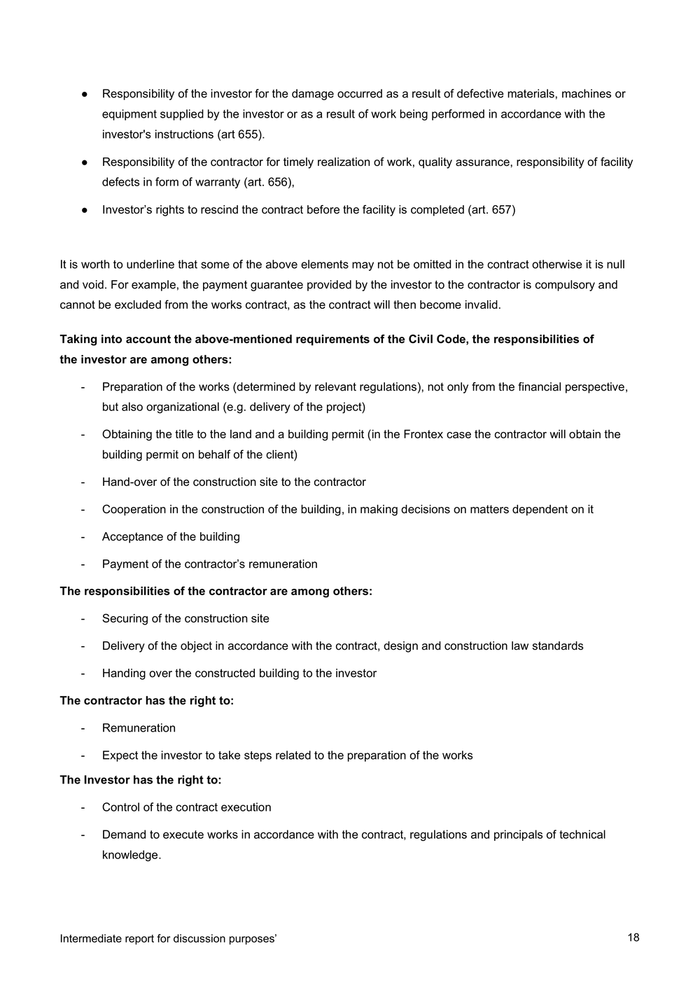
Build only or Design and Build contracting arrangements Pursuant to the provisions of the Civil Code, the investor and contractor conclude a construction works contract on the basis of a project provided by the investor ('build' formula) or a contract for the design and construction of the asset ('design and build' formula). These two types of contracting of a construction of a building are currently the most popular on the construction market in Poland (both on the public and private procurement market). The Public Procurement Office (Urząd Zamówień Publicznych) maintains a repository of master documents, however, as of today, there is no model contract for a cubature object in the abovementioned formulas. (https://www.uzp.gov.pl/baza-wiedzy/wzorcowe-dokumenty/wzorcowe-umowy) Public contracting authorities often place template contracts on their websites (e.g. local government units), in addition, the Civil Code ensures the minimum required scope of the contract. For contracts in public and commercial procurement proceedings, the contract is usually composed of the elements listed below. It should be noted that some of these elements are not described by the Civil Code, but they secure the investor's interests: Element of the contract Description Contract parties Names and addresses of the parties and the people authorized to sign the contract Contract object Brief description of the subject of the contract and contract’s scope. Preparation of project documentation based on investor's brief, obtaining building permit on the behalf of investor, execution of construction works in accordance with the project Remuneration As a standard, a flat-rate remuneration for a cubature object (lump sum). Timetable / Determining the completion date and dividing the project to milestones (eg. Schedule completion of design, completion of construction works, final settlement) The Contractor's obligation to submit the project program within e.g. 14 days from the date of signing the contract Construction site Construction site hand-over date, contractor’s responsibility, location of the construction office, investors access to the construction office Investor supervision The person representing the Investor in contact with the contractor e.g. project manager, architect, supervision inspector Design Determining which party is responsible for the design (concept, building design, execution design). In the "build" formula it is the Investor’s and in the "design and build" formula it is the contractor’s responsibility. In the second case, the way of acceptance of the design and its individual phases is determined by the Investor. Intermediate report for discussion purposes’ 19
